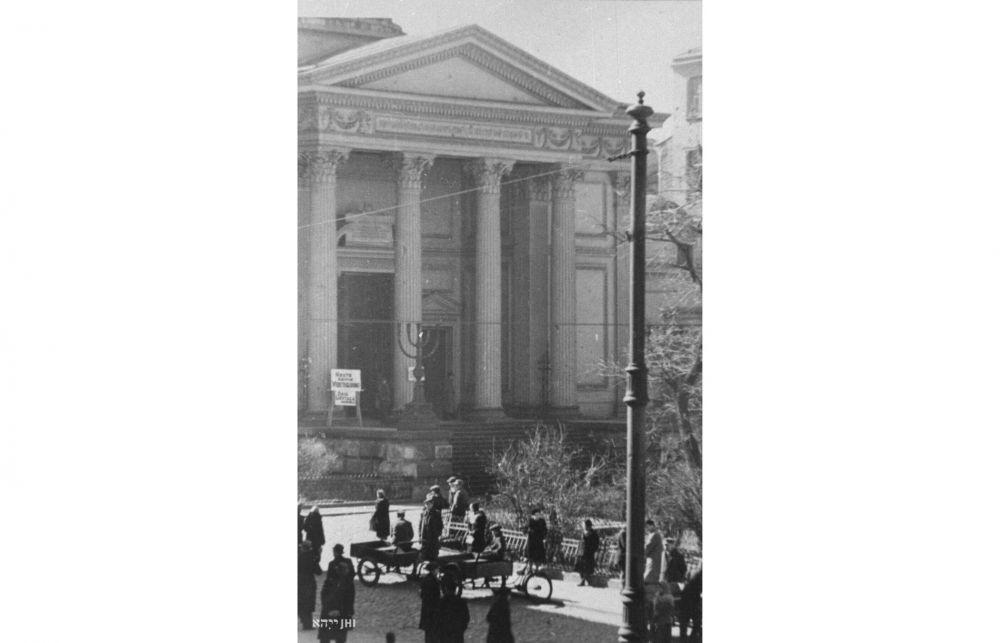- News
- Events
- Oneg Shabbat
- Collections
- Research
- Exhibitions
- Education
- Publishing Department
- Genealogy
- About the Institute
- Bookstore


The Great Synagogue on Tłomackie in Warsaw during the occupation, 1942-1943. The synagogue was closed by the Germans in January 1940. In 1942, it was used as a warehouse for furniture stolen from Jewish houses in the Warsaw Ghetto. In front of the entrance to the synagogue, you can see German guards and an inscription in German and Polish: Heute keine Versteigerung/Dziś licytacji niema, meaning: Today there is no auction, referring to furniture auction.
Photo used in the Album "Extermination of Polish Jewry". Collections of the Jewish Historical Institute
The Great Synagogue located at 7 Tłomackie Square was one of the most magnificent Polish buildings erected in the 19th century. Its ceremonial opening fell on September 26, 1878, on the festival of Rosh Hashanah – the Jewish New Year. During the ceremony, Rabbi Izaak Cylkow welcomed the Russian governor Paul Demetrius von Kotzebue, not in Russian, Hebrew, or Yiddish, but in Polish. The governor-general did not protest, which was seen as agreeing to preaching in Polish. The eternal light in front of the Aron HaKodesh was lit by Henryk Natanson, a banker and bookseller.
“We put our faith in God” – Cylkow said that day regarding Jews and Poles – “that we will never again be considered as a separate society and treated as a separate people, but as eligible sons of our country, citizens of one country (…) that the light will spread and disperse, at last, the heavy fog of prejudices and fallacies that have lingered over our mutual relations for so long.”
To this day, only the architectural plans of Leandro Marconi's work, diagrams of the ground floor and the floor plan of the women's gallery, and a few postcards picturing the building have been preserved. A trained eye, however, will also notice the resemblance of the synagogue to other well-known Warsaw buildings. Its façade resembled one of those of the Palace on the Isle belonging to Warsaw's Łazienki Park, and its representative entrance is similar to the columned portico of today's City Hall, which is located in the synagogue’s former neighborhood.
The interior of the Great Synagogue was surprising. Jews were moved by its Renaissance character and references to old Christian basilicas. There were 2,200 seats inside, a library, office, and a wedding room. A visible example of Italian inspiration were the naves with cloister arcades, the centrally located apse, in which the bimah (a platform for reading the Torah) was found as well as the Aron HaKodesh (a cabinet for storing the Torah). The upper part of the apse had a conch covered with star-shaped rosettes. The entrance of St. Anna church in Wilanów district of Warsaw is similarly constructed.
The Great Synagogue, as a center of Reform Judaism, didn’t only fulfil religious functions. There were services held on the occasion of regaining Polish independence, celebrating the 3 May Constitution Day, starting the school year. Józef Piłsudski and Ignacy Paderewski visited the place. The synagogue choir was famous for performing religious hymns, as well as works by Handel, Bach, and Vivaldi, which also inspired Christians to visit.
During World War II, the Nazis began gradually ruining the building. In January 1940 it was closed. The Germans allowed for it’s opening in November 1941. In March 1942, they excluded the area around Tłomackie Street from the ghetto, and the Great Synagogue was now outside the ghetto wall. At that time, the building began to function as a warehouse for furniture stolen by the Germans from the Jewish inhabitants of the city. By the middle of the year, there were already multiple holes in the roof of the devastated building, most of the equipment was removed or destroyed, the capitals and parts of the architraves were damaged, and the Aron HaKodesh lay knocked down on the ground.
![synagoga_wartownicy_2_zw_1.jpg [465.22 KB]](https://www.jhi.pl/storage/image/core_files/2022/5/9/8bf4305c17cc06dd37345a8fbe1d05be/jpg/jhi/preview/synagoga_wartownicy_2_zw_1.jpg)
Finally, on May 16, 1943, the Great Synagogue was blown up on the orders of Jürgen Stroop, the commander of the forces suppressing the Warsaw Ghetto Uprising. “What a beautiful sight it was! A fantastic image from the artistic and theatrical point of view. (…) A fiery explosion rose to the clouds. A terrifying roar. A fabulous blaze of colors. An unforgettable allegory of triumph over Jewry. The Warsaw Ghetto is over,” Stroop told Kazimierz Moczarski after the war.
One of the few mementoes of the most distinguished Jewish building in Warsaw is a fragment of a column and a cloakroom number belonging to the collection of the Jewish Historical Institute, which is located in the surviving building of the Main Judaic Library, once adjacent to the synagogue.
Text supplemented by Przemysław Batorski